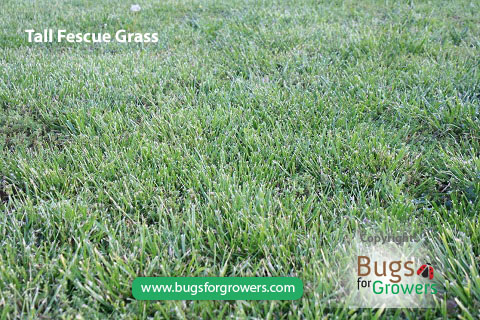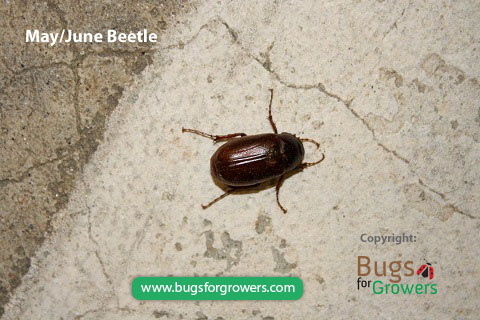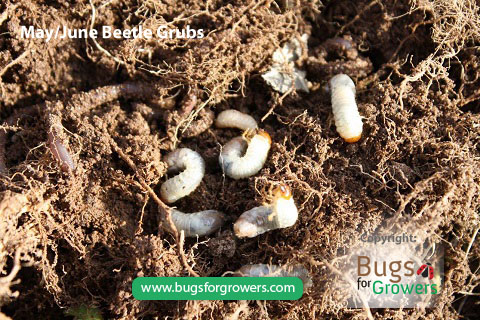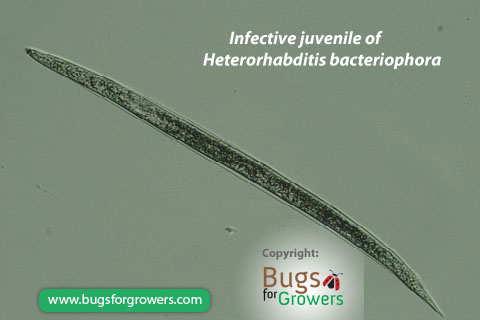What are May/June beetles?
May/June beetles are scientifically called as Phyllophaga crinita and they belong to Order Coleoptera. These beetles are considered as very important pest of many species of turfgrasses (bermudagrass, St Augustinegrass and tall fescue), vegetable crops and ornamental plants. (Fig.1). These adult beetles got their names as May/June beetles due to their routine emergence from pupae every year in early May through late June. Adult beetles are brownish black in color and about 0.5 inch long (Fig 2) whereas mature larvae are “C” shaped, about 1.0 inch long and creamy white in color with brown/orange head capsule (Fig. 3). May/June beetle larvae mainly feed on the roots whereas and adults mainly feed on the foliage of host plants.



Life cycle of May/June beetles
Life cycle of these beetles consists of four life stages including eggs, larvae (grub), pupae and adults. May/June beetles generally emerge for their pupae in early May through late June. After mating, females lay eggs about 4-5 inches deep in the soil. These eggs hatch within 3-4 weeks into small larvae called grubs, which immediately starts feeding on turfgrass roots. While feeding, larvae develop through three instars/stages. Of these instars, first two stages are completed within 2 – 3 weeks but third instar is considered as overwintering stage because it remains as larva in the soil until spring and then pupates in the soil. In the early May, adults start emerging from pupae, mate, lay eggs and life cycle continues. Depending on ambient temperature, these beetles generally complete 1- 2 generations each year.
How May/June beetles cause damage?
After hatching from eggs, small larvae also called grubs starts feeding on turfgrass roots. Heavy infestation of May/June beetles can cause yellowing and eventually death of turfgrass. This dead turf is generally loose and can be easily picked up like a piece of carpet with hands. The most important sign of presence of May/June beetle grubs in lawn is that the infested areas of lawn is destroyed by digging animals such as raccoons and skunks or by birds that are looking for grubs to feast on them. In addition to turfgrass, May/June beetles have a wide range of hosts, which include many agricultural, horticultural and ornamental plants. The larvae of this beetle mainly damages roots of their host plants whereas adults feed only on the plant foliage. Heavy feeding by adult beetles can reduce aesthetic values of many ornamental plants.
What are beneficial entomopathogenic nematodes?
Beneficial entomopathogenic nematodes are also called as insect-parasitic nematodes and can be used as biological control agents to control May/June beetles. They are defined as thread-like microscopic, colorless and un-segmented roundworms. These beneficial nematodes are the members of Steinernematidae and Heterorhabditidae families and are currently used as the excellent biological control agents against many soil dwelling insect pests of many economically important insect pests including may/June beetles (Grewal et al., 2005). Beneficial entomopathogenic nematodes are sold as infective juveniles. These infective juveniles always carry mutualistically associated symbiotic bacterial cells (Xenorhabdus spp. for Steinernematidae and Photorhabdus spp. for Heterorhabditidae) in their gut. Since these bacteria are pathogenic and capable of causing a disease to a variety of insect hosts, these nematodes are also called as entomopathogenic nematodes.
Which species of entomopathogenic nematodes are effective against May/June beetles?
Two beneficial entomopathogenic nematodes including Heterorhabditis bacteriophora (Fig. 4) and Steinernema scarabaei nematodes have been considered as an effective species against May/June beetle grubs. However, Steinernema scarabaei nematodes are not commercially produced and therefore, they are not available in the market to use against May/June beetles.

Why May and June are the best months to apply nematodes?
Because during these months both small and mature larvae and pupae of May/June beetles are present in the soil and can be easy target for nematodes. During these months, newly emerged female beetles lay eggs that hatch within 2-3 weeks into small larvae, which are very susceptible to beneficial entomopathogenic Heterorhabditis bacteriophora nematodes (Koppenhofer et al., 2004). This application can also target third instar May/June beetle larvae that are ready for pupation and target pupae before emergence of adult beetles.
What stages of May/June beetles can be targeted?
Both larvae and pupae of May/June beetles are susceptible to entomopathogenic nematodes.
How entomopathogenic Heterorhabditis bacteriophora nematodes kill May/June beetle grubs?
When the infective juveniles of entomopathogenic nematodes are applied to the soil surface or thatch layer, they start looking for their hosts including May/June beetle grubs. Once a grub is located, the nematode infective juveniles penetrates into the body cavity of May/June beetle grub via natural openings such as mouth, anus and spiracles. Inside the grub’s body cavity, infective juveniles release symbiotic bacteria, Photorhabdus spp. from their gut in the blood. when in the blood, multiplying nematode-bacterium complex causes septicemia and kill May/June beetle grubs usually within 48 h after infection. Nematodes generally feed on multiplying bacteria, mature into adults, reproduce and then emerge as infective juveniles from the cadaver to seek new May/June beetle grubs and if present, other insects hosts in the soil.
How many entomopathogenic nematodes should be applied for the effective control of May/June beetles?
For the effective control of May/June beetles, apply 23000 infective juveniles of Heterorhabditis bacteriophora.
Literature:
- Grewal, P.S., Koppenhofer, A.M., and Choo, H.Y., 2005. Lawn, turfgrass and Pasture applications. In: Nematodes As Biocontrol Agents. Grewal, P.S. Ehlers, R.-U., Shapiro-Ilan, D. (eds.). CAB publishing, CAB International, Oxon. Pp 147-166.
- Koppenhofer, A.M., Fuzy, E.M., Crocker, R.L., Gelernter, W.D. and Polavarapu, S. 2004. Pathogenicity of Heterorhabditis bacteriophora, Steinernema glaseri, and S. scarabaei (Rhabditida : Heterorhabditidae, Steinernematidae) against 12 white grub species (Coleoptera : Scarabaeidae). Biocontrol Science and Technology. 14: 87-92.
